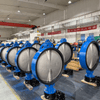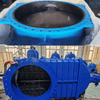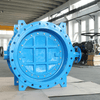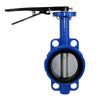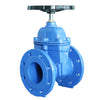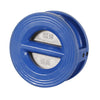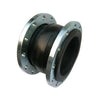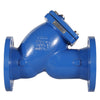Understanding 6 Common Flange Types in Piping Systems
Piping flanges are critical connecting elements in piping systems. They are mainly used to connect pipes, valves, pumps, and other equipment or components. Flanges not only serve as connectors but also provide a sealing function, preventing fluid leakage and ensuring efficient fluid flow within the system.
There are various ways in which piping flanges can connect to pipes. Today, we will explain the six most common types of flange connections used in piping systems.
- Socket-Welded Flanges
- Slip-On Flanges
- Weld Neck Flanges
- Threaded Flanges
- Blind Flanges
- Lapped Flanges
Socket-Welded Flanges
Socket-welded flanges have a socket in the inner bore of the flange, where the pipe is inserted and welded. When using this type of flange, the inner diameter must match the inner diameter of the pipe.
The connection with the pipe is completed by fillet welding on the outside of the flange.
Application:Socket-welded flanges are only suitable for pipelines with a nominal diameter of DN80 or below.

Slip-On Flanges.
Slip-on flanges have a bore that matches the outer diameter of the pipe, allowing the pipe to pass through. The flange is placed over the pipe and is fillet welded from both the inside and outside.
The connection to the pipe is completed by two fillet welds, one on the inside and one on the outside of the flange.
Application: Slip-on flanges are suitable for low-pressure and low-temperature applications, and this type of flange is available in larger sizes.


Weld Neck Flanges
They differ from other flanges by having a long, tapered neck that extends from the weld joint to the flange plate. The thickness of this neck gradually transitions to match the pipe wall thickness, improving stress distribution and increasing the flange’s strength.
The connection to the pipe is made with a single full penetration butt weld.
Weld neck flanges are primarily used in demanding conditions. They are large, heavy, and expensive, but their design is reasonable, with high strength and rigidity, making them capable of withstanding high temperatures, high pressures, repeated bending, and temperature fluctuations.
Application: Due to their excellent performance, weld neck flanges are widely used in large vessels in industries like aerospace, petroleum, and chemical processing. They are especially suitable for pipelines subject to pressure or temperature fluctuations, as well as high-temperature, high-pressure, and low-temperature conditions. They are also used in pipelines that transport expensive, flammable, explosive, or toxic gases.

Threaded Flanges
The bore of the flange is threaded to match the threads of the pipe, enabling connection without welding. Compared to welded flanges, threaded flanges offer easier installation and maintenance.
The connection to the pipe is achieved by screwing, without the need for welding.
Application: Suitable for pipelines where on-site welding is not permitted, such as fire protection, gas, and industrial or residential hot and cold water systems. However, it is not recommended to use threaded flanges in conditions with rapid temperature changes or temperatures above 260°C or below -45°C to avoid leakage.

Blind Flanges
Blind flanges have no hub or center bore and are mainly used to seal the open end of pipes or containers.
They have the same bolting pattern for connection to the pipeline.
Application: Used to isolate and block pipelines for equipment inspection, cleaning, replacement, or other maintenance work. They can be easily removed, making them convenient for repairs.

Lapped Flanges
Lapped flanges consist of two components: a stub end and a loose flange. The stub end is butt-welded to the pipe, while the loose flange can move freely on the pipe. The flange material can be different from the stub end, often made of carbon steel to reduce costs. It is commonly used in locations where frequent disassembly is required and space is limited.
Compared to socket-welded and threaded flanges, lapped flanges provide a better connection through butt welding. However, unlike threaded, slip-on, and socket-welded flanges, they are not suitable for small-sized, expensive components or complex manufacturing.
Application: Lapped flanges offer flexibility in connection since they can rotate freely on the pipe. They are ideal for locations requiring frequent disassembly and where space is limited.

Main Technical Parameters Of Flanges
Nominal Diameter (DN)
Definition: Nominal diameter is the standard diameter of the flange, indicating the size of the connected pipe or equipment. It is usually represented by DN (nominal diameter) in millimeters (mm). It is a crucial reference for selecting the flange.
Nominal Pressure (PN)
Definition: Nominal pressure is the maximum allowable working pressure of the flange at a specified reference temperature. It indicates the pressure-bearing capacity of the flange and is usually represented by PN in megapascals (MPa). It is one of the key parameters for flange design and selection, directly affecting the sealing performance and safety of the flange.
Material Type
Flanges are made from a variety of materials, such as carbon steel, stainless steel, and alloy steel. Different materials have distinct physical and chemical properties, making them suitable for different working environments and conditions. The choice of material directly impacts the flange’s strength, corrosion resistance, wear resistance, manufacturing cost, and service life.
Sealing Surface Type
Flange sealing surface types include Full Face (FF), Raised Face (RF), Male-Female Face (MFM), Tongue-Groove Face (TG), and Ring Joint Face (RJ), each suited for different sealing requirements.
Flange Manufacturing Standards
These include national standards (e.g., GB/T), Mechanical Department Standards (e.g., JB/T), Chemical Industry Standards (e.g., HG), American Standards (e.g., ANSI B16.5), British Standards (e.g., BS), German Standards (e.g., DIN), and Japanese Standards (e.g., JIS B2220-2012).
In conclusion, the main technical parameters of flanges cover nominal diameter, nominal pressure, material type, flange manufacturing standards, and other related parameters. These parameters collectively determine the performance and application range of flanges and serve as important criteria for flange selection and usage.
Union Valve is a professional valve manufacturer that offers a wide range of standard valves as well as custom designs to meet clients' specific requirements. For more information, please contact us.
Related Article:
- Do you know the 8 common API valve standards?
- Choosing the Right Valves for Efficient Water Supply Systems
- What is Cv? A Guide to Valve Flow Coefficient Explained
- Recommend the Top ten Butterfly Valve Manufacturers With the Best Quality in China

-
Posted in
flange


